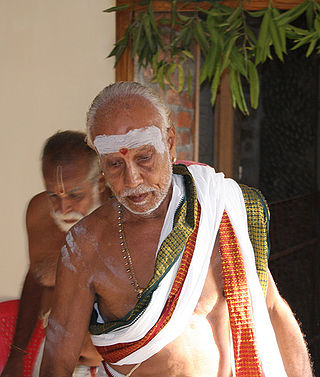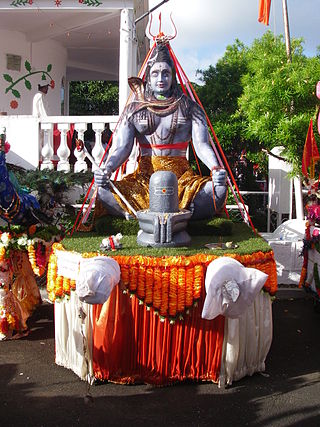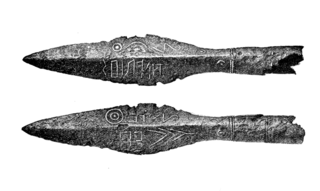Related Research Articles

Zoroastrianism, also known as Mazdayasna and Behdin, is an Iranian religion. One of the world's oldest organized faiths, it is based on the teachings of the Avesta and the Iranian prophet Zoroaster. It has a dualistic cosmology of good and evil within the framework of a monotheistic-style ontology; meaning that the religion's eschatology predicts the ultimate triumph of good over evil. Zoroastrians exalt an uncreated and benevolent deity of wisdom, commonly referred to as "Ahura Mazda", as the universe's supreme being; opposed to Ahura Mazda is "Angra Mainyu", who is personified as a destructive spirit and the adversary of all things good. Historically, the unique features of Zoroastrianism, such as monotheism, messianism, belief in free will and judgement after death, conception of heaven, hell, angels, and demons, among other concepts, may have influenced other religious and philosophical systems, including the Abrahamic religions and Gnosticism, Northern Buddhism, and Greek philosophy.
A coven is a group or gathering of witches. The word "coven" remained largely unused in English until 1921 when Margaret Murray promoted the idea that all witches across Europe met in groups of thirteen which they called "covens".
A nocturnal emission, also known as a wet dream, sex dream, or sleep orgasm, is a spontaneous orgasm during sleep that includes ejaculation for a male, or vaginal lubrication and/or an orgasm for a female.

Iyers are an ethnoreligious community of Tamil-speaking Hindu Brahmins. Most Iyers are followers of the Advaita philosophy propounded by Adi Shankara and adhere to the Smarta tradition. This is in contrast to the Iyengar community, who are adherents of Sri Vaishnavism. The Iyers and the Iyengars are together referred to as Tamil Brahmins. The majority of Iyers reside in Tamil Nadu, India.
Garifuna music is an ethnic music and dance with African, Arawak, and Kalinago elements, originating with the Afro-Indigenous Garifuna people from Central America and Saint Vincent and the Grenadines. In 2001, Garifuna music, dance, and language were collectively proclaimed as a Masterpiece of the Oral and Intangible Heritage of Humanity by UNESCO.

Maha Shivaratri is a Hindu festival celebrated annually in honour of the deity Shiva, between February and March. According to the Hindu calendar, the festival is observed on the fourteenth day of the dark (waning) half of the lunar month of Phalguna or Magha. The festival commemorates the wedding of Shiva and Parvati, and the occasion that Shiva performs his divine dance, called the Tandava.

A magic circle is a circle of space marked out by practitioners of some branches of ritual magic, which they generally believe will contain energy and form a sacred space, or will provide them a form of magical protection, or both. It may be marked physically, drawn in a material like salt, flour, or chalk, or merely visualised.

The Torajans are an ethnic group indigenous to a mountainous region of South Sulawesi, Indonesia. Their population is approximately 1,100,000, of whom 450,000 live in the regency of Tana Toraja. Most of the population is Christian, and others are Muslim or have local animist beliefs known as aluk. The Indonesian government has recognised this animistic belief as Aluk To Dolo.

The phurba or kīla is a three-sided peg, stake, knife, or nail-like ritual implement deeply rooted in Indo-Tibetan Buddhism and Bön traditions. Its primary association is with the meditational deity Vajrakīlaya, embodying the essence of transformative power. The etymology and historical context of the term reveal some debate. Both the Sanskrit word "kīla" and the Tibetan "phurba" are used interchangeably in sources.

Sacramental bread, also called Communion bread, Communion wafer, Sacred host, Eucharistic bread, the Lamb or simply the host, is the bread used in the Christian ritual of the Eucharist. Along with sacramental wine, it is one of two elements of the Eucharist. The bread may be either leavened or unleavened, depending on tradition.

A veve is a religious symbol commonly used in different branches of Vodun throughout the African diaspora, such as Haitian Vodou and Louisiana Voodoo. The veve acts as a "beacon" for the lwa, and will serve as a lwa's representation during rituals.

Apotropaic magic or protective magic is a type of magic intended to turn away harm or evil influences, as in deflecting misfortune or averting the evil eye. Apotropaic observances may also be practiced out of superstition or out of tradition, as in good luck charms, amulets, or gestures such as crossed fingers or knocking on wood. Many different objects and charms were used for protection throughout history.
Purity is an essential aspect of Islam. It is the opposite of najāsa, the state of being ritually impure. It is achieved by first removing physical impurities from the body, and then removing ritual impurity through wudu (usually) or ghusl.

Pahlevani and zourkhaneh rituals is the name inscribed by UNESCO for varzesh-e pahlavāni or varzesh-e bāstāni, a traditional system of athletics and a form of martial arts originally used to train warriors in Iran (Persia), and first appearing under this name and form in the Safavid era, with similarities to systems in adjacent lands under other names. Outside Iran, zoorkhanehs can now also be found in Azerbaijan, and Afghanistan, and were introduced into Iraq in the mid-19th century by the Iranian immigrants, where they seem to have existed until the 1980s before disappearing. It combines martial arts, calisthenics, strength training and music. It contains elements of pre-Islamic and post-Islamic culture of Iran with the spirituality of Persian Shia Islam and Sufism. Practiced in a domed structure called the zurkhāneh, training sessions consist mainly of ritual gymnastic movements and climax with the core of combat practice, a style of folk wrestling called koshti pahlavāni.

Chōzu-ya or temizu-ya (手水舎) is a Shinto water ablution pavilion for a ceremonial purification rite known as temizu or chōzu. The pavilion contains a large water-filled basin called a chōzubachi.
The cone of power is a method of raising energy in ritual magic, especially in Wicca. The cone of power is visualized as a cone of energy that encompasses the circumference of the magic circle of Wiccans and tapering off to a point above the group. As a group, the cone is formed by the Wiccans standing in a circle, sometimes holding hands, and focusing on a single point above the group and in the centre of the circle. They then dance, drum, chant, or perform various other ritual gestures, in order to raise the energy and extend it upwards. When the state that these actions create has reached a peak, the ritual leader will signal the group and the energy is released upwards and the cone is “sent” towards the goal. This is called "Raising the Cone of Power".
Ambalavasi, more properly Ampalavasi, is the generic name for a group of castes among Hindus in Kerala, India, who have traditionally rendered temple services.

Bloody Mary is a legend of a ghost, phantom, or spirit conjured to reveal the future. She is said to appear in a mirror when her name is chanted repeatedly. The Bloody Mary apparition may be benign or malevolent, depending on historic variations of the legend. Bloody Mary appearances are mostly witnessed in group participation play.

The Xhosa people, or Xhosa-speaking people are a Bantu ethnic group whose traditional homeland is primarily the Eastern Cape Province of South Africa. They received the name Xhosa from the Khoi, meaning the violent angry people. Southern Africa IsiXhosa language.

Gothic paganism was the original religion of the Goths before their conversion to Christianity.
References
- ↑ Singh, K. S.; Halbar, B. G. (2003). Karnataka. Anthropological Survey of India. p. 124. ISBN 978-81-85938-98-1.